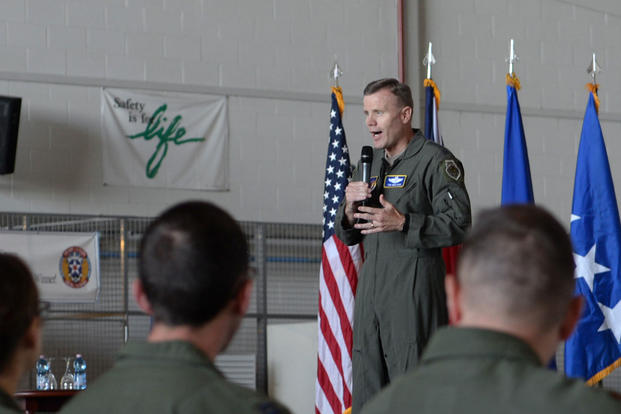RAF FAIRFORD, England -- Building up airfields so that U.S. bombers, fighters and other aircraft can land safely on Europe's eastern front was not a project the U.S. Air Force predicted.
But nearly five years after Russia occupied parts of eastern Ukraine, with Baltic countries fearful of a similar fate, the U.S. is dedicating millions to build up small hubs designed to house a quick-reaction force.
"They're incredibly necessary to improve deterrence," said Gen. Tod Wolters, commander of U.S. Air Forces Europe-Africa. He sat down with Military.com here during the Royal International Air Tattoo on Friday ahead of the Farnborough Airshow.
The goal is to effectively build up locations closer to Eastern Europe to support "strike, superiority, surveillance, command and control and [air]lift," he said. "All aircraft are involved."
Related content:
- Aircrews Can Expect Busy Training Year in Europe: General
- In Reversal, White House Trade Director to Skip Farnborough Airshow
- Military.com Farnborough Airshow Coverage
The mission sets "require all of our aircraft inventory, and those aircraft that are part of the NATO element to do the same," Wolters said.
He said he's been pushing presence, training and infrastructure in his USAFE role.
"We've done well with presence, because we've had assistance from our partners from the NATO perspective to show up," Wolters said. Now, USAFE is "really focused on training and infrastructure. So the number of exercises that we have in the right spots, with the right people, with the right training scenario, with the correct setting are improving with each year -- not just in the numbers of exercise[s], but what they're focused on."
Better training increases readiness and the ability to deter threats, adding to the success of the European Deterrence Initiative, he said.
The Defense Department's 2019 fiscal budget request asks for $6.5 billion for the EDI, or nearly $2 billion more than the previous fiscal budget, and nearly double the $3.4 billion the DoD received in fiscal 2017.
The EDI -- prompted in 2014 as a result of Crimea's annexation and originally called the European Reassurance Initiative -- has helped the Air Force fuel its ambitious outreach to partners in Europe, as well as planning the modular airfields it wishes to construct or beef up in response to Russia's aggressive behavior in the East.
USAFE went from "2014, a famine of funding, to a feast with the [European Reassurance Initiative] funding in 2015, and that's when training and exercises kicked off," Lt. Col. Bradley Brandt, branch chief of operations and training for the command, told Military.com last year.
The fiscal 2019 budget request for EDI would use about $830 million to boost infrastructure across all the services, according to a report from Defense News. Roughly $363.8 million would go to the Air Force, more than a 300 percent increase in funding since fiscal 2017.
Work has been progressing in the Baltics, Romania and Poland, among other locations, to improve and modify locations aircrews and maintainers can utilize when aircraft land for missions there.
"We are seeing steady, slow improvement in all those areas, and I say 'slow' only from the standpoint as a compliment, because it needs to be steady and slow to ensure all of the domains and all of the regions and all of the functions on the European continent can accept these soldiers, sailors, airmen and Marines -- in our case, our airmen -- to do the things they need to do to improve their [missions]," Wolters said.
He said infrastructure improvements include runways, arming facilities, security, and maintenance facilities at Baltic bases and in Poland.
The service anticipates someday "putting more aircraft into those locations on an episodic basis, and fly on ranges that have improved through coordination at higher levels to where crews get better training, they fly more sorties, and are able to do more than they have been able to do in the past," he said.
That includes the ability to change weapons in and out of aircraft faster.
"You can upload and download the munitions that you need to upload or download on a much quicker basis. That improves their training. And this has happened for the last two-and-a-half years in a very productive fashion in Estonia, Latvia, Lithuania and Poland," Wolters said.
Allies are following suit with similar buildups.
For example, the Swedish air force is looking to reconfigure dozens of auxiliary airfields used during the Cold War for future operations.
The Swedes are also pushing for additional training with partners, including the U.S.
"The situation in the Baltics has made NATO deploy air forces around the Baltic sea, northern Poland ... and there is a great interest in those air forces, [for us] to train with right now," said Col. Lars Bergström, commander of the F 17 Swedish Air Force Wing.
Bergström joined Maj. Gen. Mats Helgesson, chief of the Swedish air force, speaking at the RAF Club here in London on Sunday.
Interest in training together is expressed "on a weekly basis, which is very good for us," including "red air" or aggressor air training, Bergström said.
All the Eastern European nations are keeping a watchful eye, especially when it comes to intelligence gathering.
"To increase your deterrence capability, you have to have better strategic and operational indications and warnings, and ... better strategic and operational command and control feedback. And these [remotely piloted aircraft] obviously enhance our ability to see from a reconnaissance standpoint," Wolters said.
Surveillance "applies to all the regions" across Europe, he said.
When asked what his message as an air chief for NATO partners and allies is, he said, "We continue to footstomp the importance of owning your skills with exercise and training and making sure you can make your forces as ready as possible."
-- Oriana Pawlyk can be reached at oriana.pawlyk@military.com. Follow her on Twitter at @Oriana0214.










